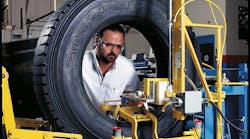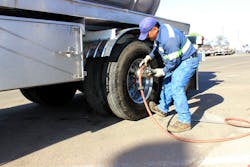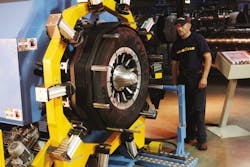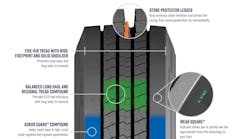Editor's note: The second part of a two-part series on digital tire management programs explores psi and tread depth. Read part one.
According to federal regulations, a commercial motor vehicle cannot operate when a tire has a cold inflation pressure less than what is specified for the load being hauled. And because underinflation is the leading cause of tires not reaching their full life expectancy, Steve Miller, vice president of engineering for P.S.I. expressed the importance of fleets being alerted well before the point where underinflation is detrimental to the casing.
Minimum federal tread depth levels are set at 4/32nds for steer tires, and 2/32nds for drive and trailer tires.
When using the Meritor Tire Inflation System (MTIS), P.S.I. advises that technicians set the pressure at the right cold tire pressure when they are replacing a vehicle’s tires. “One of the things that we suggest in our documentation is install tires 5-10 psi below the cold pressure and let the automatic tire inflation system bring it back up to the proper cold tire pressure,” Craig Smith, marketing manager for P.S.I., explained.
Overall, telematics and the ability to leverage and analyze data to make informed decisions to be proactive, rather than being reactive, have become the norm across fleet operations, Miller pointed out. “Fleets are able to slice that data in a lot of different ways to see how their tires are performing,” Miller said. “The first step is getting that data to them to analyze to see what they can do to optimize their performance.”
When a tire event occurs and illuminates the P.S.I. warning light on the trailer, an alert is also transmitted to the back office, allowing the fleet to schedule maintenance. The addition of TPMS sensors will also provide specific information regarding which tire needs repair.
Fleets can set up alerts for high temperature, and high and low pressure by axle group, Smith said. “We’ve noticed during a lot of tests with fleets that dragging brakes can result in a rise in temperature of the tire,” he noted. “We’re finding new ways to use these sensors all the time.”
The correct inflation pressures for fleet tires must incorporate many factors including load, vehicle speed, road surface, and handling, explained Brandon Gray, operational marketing manager, B2B Services, for Michelin North America. He pointed to Michelin’s Truck Tire Service Manual, which includes detailed information about tire maintenance and the impact of tire air pressure.
“A tire’s air pressure is important because heavy-truck load weight can be quite high,” Michelin pointed out. “If the tire is 20% below the recommended pressure, it must be considered flat. It should then be removed and inspected for punctures or other damage. Failure to do so may lead to unwanted downtime.”
Michelin also recommends maintaining all tires at the fleet target inflation pressure based on the manufacturers’ application data book for the particular axle load. An inflation pressure mismatch of greater than 5 psi will result in the two tires of a dual assembly being significantly different in circumference resulting in irregular wear and can also lead to eventual tire loss due to premature casing fatigue. According to Michelin, a difference of 5 psi between steer tires will cause the vehicle to pull to the side with the lower pressure.
Additionally, underinflation can result in internal tire heat buildup and potentially premature tire failure. Underinflated tires build up excessive heat that can result in tire destruction and/or improper vehicle handling. According to the American Trucking Associations Technology & Maintenance Council, a constant 20% underinflation will reduce tire life by 30%, and 40% underinflation will reduce tire life by 50%.
“Underinflation is the biggest issue in the industry,” Gray reiterated. “It is the number-one cause of premature tire removal. With the advancement in today’s radial casing, it is virtually impossible to determine if a tire is properly inflated without using a pressure gauge. Over time, usage conditions can cause a pressure gauge to lose accuracy beyond the 2 psi manufacturer's tolerance range. Periodically calibrate the gauges using a master gauge. The time and effort required to verify gauges and to check tire pressure is time well spent.”
Gary Schroeder, executive director of Cooper Tire & Rubber’s Global Truck and Bus Tire Business added that another problematic area, specifically for fleets running retreaded tires, is using retreads that don’t match in circumference.
“In some cases, fleets will get identical retreads back from their retreader, but the casings may be different,” Schroeder said. “Each brand and model may have a slightly different diameter, so while two tires will look identical when you get them back from the retreader, one may be significantly taller than the other. If you put together duals that should be identical but are actually mismatched in height, that will cause one tire to wear prematurely.”
Schroeder added that this same problem can occur between duals even if the tires are perfectly identical and have the same circumference. If there is just a 5 psi difference between duals, that can cause one of the tires to wear more quickly than the other, he said.
By working with their technology solutions partners, fleets can set up targeted psi levels and where and how they want to be notified when a tire is underinflated. They can also set up alerts for gaps in tread depth, or mismatched duals, and pull-point targets.
When it comes to tire air pressure, Tom Clauer, Yokohama Tire senior manager of commercial product planning, a key to maximizing performance and ensuring safety is knowing the correct air pressure to handle the loads. He suggests fleets set up and maintain rigorous driver and technician air pressure inspection practices.
Clauer also noted the importance of ensuring any irregularities in tire wear are addressed immediately, and that includes alignment checks. Alignment checks should be included in equipment maintenance schedules, both power and trailer.
“Data is invaluable in measuring performance,” Clauer said. “Once you have the parameters set and classification categorized for each unit, you can then begin to compare performances. Anything performing outside of established benchmarks needs to be addressed.”
Tread life and retreading
By maintaining proper tire pressure fleets are not only getting the best fuel economy possible, but it can also increase tread life. Sustaining the proper pressure for the life of the tire enables the casing itself to be reused as a retread, P.S.I.’s Smith pointed out.
For many fleets, retreads are a way to maximize their bottom line. By using a retreading program, they can offset initial new tire costs and spread that cost out over multiple tread life cycles.
“Retreading is a vital part of any fleet operation,” explained Yokohama’s Clauer. “There are a few exceptions where fleets may choose to use virgin tires exclusively. Even in these situations, retread programs are beneficial for fleets because by selling back the casing, they generate money from a retreading dealer. This can easily offset original tire purchase costs.”
Clauer added that premium new tires can be retreaded multiple times, thus expanding the usability of the casing.
“Technicians and drivers need to know and understand that just ‘sticking’ and measuring tread depths is not enough,” Clauer explained. “They need to do a complete 360-degree visual inspection. There could be irregular wear patterns in which lower tread depths could be found. The lowest tread depth – not the average tread depth – is the measurement that must be used. Road inspections have set measurements and will look for and use the lowest tread depth they can find.”
However, having precise pull points is important because pulling tires too soon, according to Josh Schwartz, head of business development for real-time remote tire management provider Revvo, results in unnecessary tire waste and unused tread.
“The perfect pull point requires data, insights, and guidance,” Schwartz advised. “The perfect pull point requires a remote tire management platform.”Dustin Lancy, product marketing manager for North America Commercial at Goodyear, explained that most of Goodyear’s larger customers are doing retreading and that it has become an integral part of their tire management program.
Goodyear’s GTRACS solution is a retread management system that helps track the casing lifecycle from when that product initially comes in. It tracks the health of the casing, how many retreads it has had, and notes on repairs can be added into the system.
“When that product comes back from the fleet to be retreaded, we can do the proper inspections to make sure that casing is eligible to be retreaded again and to go back into the fleet for use once again after it’s been retreaded,” Lancy explained.
“Casing is like a $100 bill to a fleet if it hasn’t been retreaded,” Lancy added. “You want to take care of that investment because that is what will help a fleet maximize its total cost per mile over time.”
And that’s exactly what Canada-based Len Dubois Trucking is doing. Derek Quinn, maintenance manager at Len Dubois, expects to see improvements in the fleet’s kilometers per tread using Dana's Rhombus TireAnalytics system.
“We retread quite a bit,” Quinn pointed out. “That’s probably most of our tires, and it’s mostly on our trailers.
When Len Dubois Trucking buys a new truck, that asset will come with all-new virgin casings that will eventually run their lifecycle and will be cycled through the fleet’s retread plan, Quinn explained. Currently, a new drive tire will get one set of retreads, then it will get retreaded into a trailer tire. Eventually, after the casing is retreaded multiple times, it will go onto a unit that is being returned to the dealer and cycled out of the company’s system.
“We have an agreement with Michelin where they will warranty our casings up to three retreads,” Quinn said. We basically have a written guarantee from that manufacturer that the fleet can recap a tire up to three times in any configuration. [Rhombus] will just complement that and help track that better.”
Quinn expects that by retreading and using a digital tire management program, the fleet’s tire costs will drop 10-15% in the first year alone.
Coaching opportunities
Fleets can also use the data coming off their tires to better train their technicians and drivers on best practices to get the most optimal life from their assets.
Fleets using Goodyear’s TireOptix or CheckPoint solutions, for instance, have been able to use these technologies as coaching opportunities with their technicians, noted Austin Crayne, business development lead for Goodyear. Goodyear has seen fleets use TireOptix across multiple yards and has found air inflation issues or that some yards are running into specific wear conditions on their tires. In addition, Goodyear’s TPMS has also been able to highlight tire damage or leaks in certain instances after a driver clipped a curb.
“If you start to see those patterns in the data, then you can use it as an opportunity to go talk to your driver,” Crayne said. “Address the issue through proper training of the drivers to avoid that issue long term to save costs in the long run.”
With Rhombus’ image capture capabilities, Dana has seen fleet managers use images as a proof of completion for technicians. Technicians can take pictures and indicate on the image where they see accelerated tire wear or other problems.
“If you’ve got a tire that isn’t making it to its desired pull point, then you can see what the systemic issue affecting that tire is—whether it be performance-based or something happening on the road, negligence or abuse on behalf of the equipment operator, or is it a systemic mechanical problem, like mismatched duals, alignment issues, suspension issues, and so on,” Shaun Hartoog, digital solutions specialist at Dana, pointed out.
By customizing a tag via Rhombus, Hartoog said one fleet customer created a chain damage plan after managers started seeing an excessive number of tires coming in for inspections with visible chain damage over a three- or four-month period. As the fleet tracked that damage, management found it was happening on a certain route and for a specific contract.
“They took that upon themselves to train their drivers that this is due to an improper chaining technique, and that’s why these tires are getting damaged,” Hartoog said. “They are protecting their tires, their cost of investment by identifying what type of wear was happening, and they were able to make a retraining decision to mitigate that issue.”
Matthew Berg, director of professional services for Rhombus, added that one of the main goals that Rhombus has is to notify a fleet manager immediately when something is wrong with the tire.
During a 30-minute conversation with FleetOwner, Quinn received three tire alerts from the Rhombus system that he had to immediately handle. In a two-month period, Quinn said that the system has allowed technicians to measure more than 750 tires, or 50% of the fleet.
“Before that, when the trailers would come in for service, a technician would check them with a pressure gauge and just jot down the pressure,” Quinn explained. “That paper record would hopefully get across somebody’s desk if the technician felt like there was an issue. But what is not an issue to him might be important to me or vice versa, so a lot of times, tires were not being dealt with. So, I know in real-time now. As soon as the inspection is done, I get an alert.”
“These trailers will get serviced and then go on the road right away, so anything we can do right now to mitigate tire issues on the road is money in the bank,” Quinn added.
Overall, the Rhombus system is designed to provide feedback to the technicians via a post-inspection report, Berg noted. Over time, the goal is that technicians begin to learn what their managers' expectations are for tire treatment and anticipate how to mitigate tire problems ahead of time.
Ultimately, that’s the case and end goal for any digital tire management program. As fleets rely more and more on the data coming off their assets to make the best decisions possible, the old ways of maintaining tires and leaving a paper trail behind are fading.






